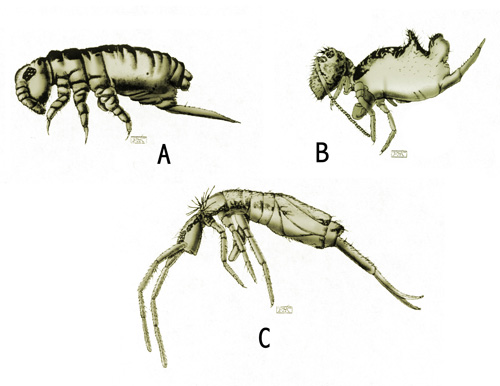One of the most unusual, and smallest, insect inhabitants of Texas lawns are springtails. Far from being harmful, springtails serve as decomposers, one of a community of organisms that help break down organic matter and return valuable nutrients to the soil. Springtails can be found in compost bins, lawns, mulch or nearly anywhere in soil or leaf litter. Occasionally, however, springtails become a nuisance around homes.
Identification
Springtails are among the smallest insects in the home landscape. Typical species are about .04 inch-(1 mm-) long, barely visible to the eye. Springtails are wingless and do not fly, but under a hand lens or microscope one can see a long tail, which is normally kept folded under the body. This tail, when sprung from its folded position, enables these insects to jump, much like miniature fleas.
Springtails come in a variety of shapes, colors and sizes, but to the human eye usually appear as small, grey specks. Springtails can be distinguished from fleas by their appearance and much smaller size. Unlike fleas, springtails do not bite and will not infest or annoy people.
Biology and control
Springtails belong to one of the most primitive insect groups, the Collembola. Springtails live outdoors in moist environments where they can feed on decaying plant material, fungi and bacteria. Some species are believed to feed on such unusual foods as algae, pollen and insect feces.
Because of their small size, springtails would rarely be noticed except for their remarkable ability to reproduce. During periods of favorable humidity and food supply springtails can reach population densities of up to 100,000 per cubic yard of surface soil. When numbers reach outbreak levels springtails may be found indoors on floors and around windows. Swimming pools are occasionally covered with a fine scum made up of millions of tiny springtails floating on the water surface.
Control of springtails is rarely effective under such conditions. Once indoors springtails generally die quickly with or without insecticide sprays. Outside treatment of the foundation perimeters with insecticides may provide some relief; however infestations are usually short-lived, less than a couple of weeks. Look for a long-lasting outdoor spray such as those containing permethrin, bifenthrin, cyfluthrin or similar products.
Springtails occasionally become pests in potted plants. Insecticide drenches with permethrin or other insecticide labeled for use in potting soil should effectively control springtails.
For more information
For more information on springtails and their control, request publication E-214, Springtails. This publication, and help with additional questions about fleas or other pest problems, can be obtained by contacting your county Extension office. For more information about residual insecticides, see the F@ctSheet ENT-4002, Understanding Common House & Garden Insecticides.
Author:
Michael Merchant, Ph.D., Professor and Extension Urban Entomologist, Texas AgriLife Extension Service

